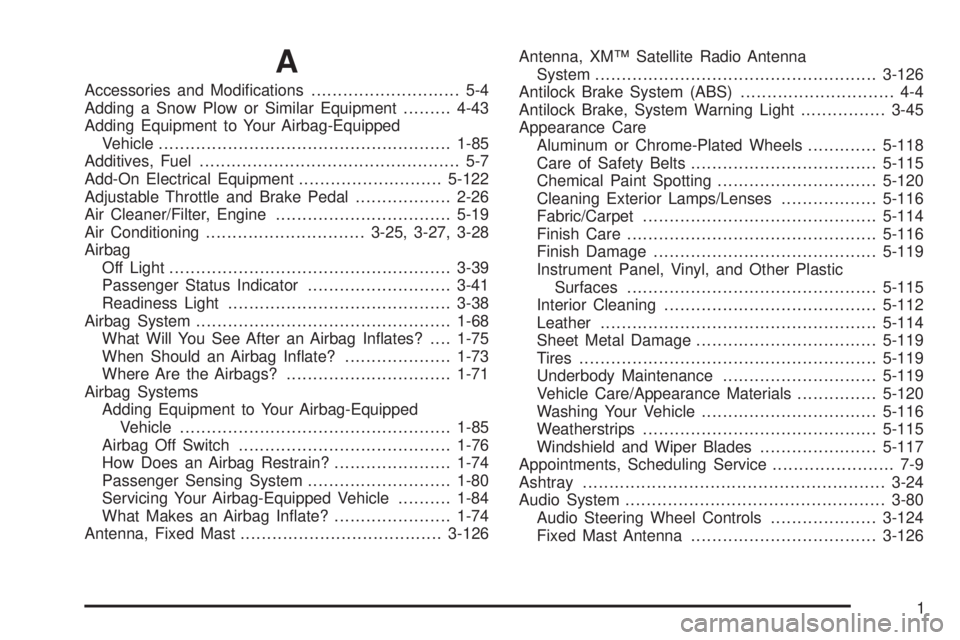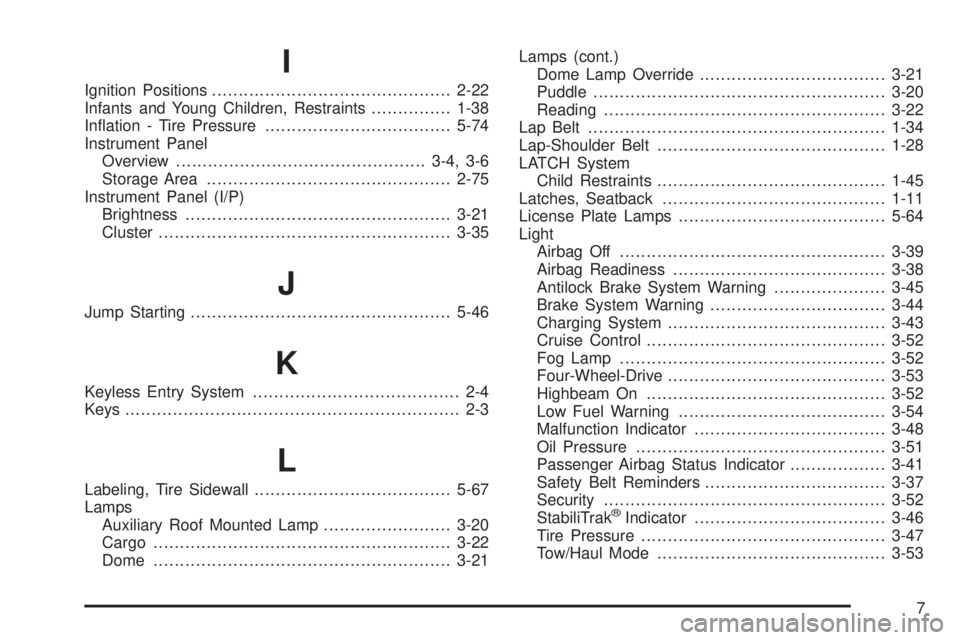2008 GMC SIERRA warning light
[x] Cancel search: warning lightPage 436 of 578

Brake Wear
Your vehicle has front disc brakes and could have rear
drum brakes or rear disc brakes.
Disc brake pads have built-in wear indicators that make
a high-pitched warning sound when the brake pads
are worn and new pads are needed. The sound can
come and go or be heard all the time your vehicle is
moving, except when you are pushing on the brake
pedal �rmly.
{CAUTION:
The brake wear warning sound means that
soon the brakes will not work well. That could
lead to an accident. When you hear the brake
wear warning sound, have your vehicle
serviced.
Notice:Continuing to drive with worn-out brake
pads could result in costly brake repair.
Some driving conditions or climates can cause a brake
squeal when the brakes are �rst applied or lightly
applied. This does not mean something is wrong with
the brakes.Properly torqued wheel nuts are necessary to help
prevent brake pulsation. When tires are rotated, inspect
brake pads for wear and evenly tighten wheel nuts in
the proper sequence to torque speci�cations in
Capacities and Specifications on page 5-130.
If you have rear drum brakes, they do not have wear
indicators, but if you ever hear a rear brake rubbing
noise, have the rear brake linings inspected immediately.
Rear brake drums should be removed and inspected
each time the tires are removed for rotation or changing.
Drum brakes have an inspection hole to inspect lining
wear during scheduled maintenance. When you have
the front brake pads replaced, have the rear brakes
inspected, too.
Brake linings should always be replaced as complete
axle sets.
Brake Pedal Travel
See your dealer/retailer if the brake pedal does not
return to normal height, or if there is a rapid increase in
pedal travel. This could be a sign that brake service
might be required.
Brake Adjustment
Every time you make a brake stop, the brakes adjust
for wear.
5-44
Page 470 of 578

Tire Pressure Monitor Operation
The Tire Pressure Monitor System (TPMS), if your
vehicle has this feature, is designed to warn the driver
when a low tire pressure condition exists. TPMS sensors
are mounted onto each tire and wheel assembly,
excluding the spare tire and wheel assembly. The TPMS
sensors monitor the air pressure in the vehicle’s tires
and transmits the tire pressure readings to a receiver
located in the vehicle.
When a low tire pressure
condition is detected, the
TPMS will illuminate the
low tire pressure warning
symbol located on the
instrument panel cluster.
At the same time a message to check the pressure in a
speci�c tire appears on the Driver Information Center
(DIC) display. The low tire pressure warning light and
the DIC warning message come on at each ignition cycle
until the tires are in�ated to the correct in�ation pressure.If your vehicle has DIC buttons, tire pressure levels can
be viewed by the driver. For additional information and
details about the DIC operation and displays seeDIC
Operation and Displays (With DIC Buttons) on page 3-55
orDIC Operation and Displays (Without DIC Buttons)
on page 3-60andDIC Warnings and Messages
on page 3-63.
The low tire pressure warning light may come on in cool
weather when the vehicle is �rst started, and then turn
off as you start to drive. This could be an early indicator
that the air pressure in the tire(s) are getting low and
need to be in�ated to the proper pressure.
A Tire and Loading Information label, attached to your
vehicle, shows the size of your vehicle’s original
equipment tires and the correct in�ation pressure for
your vehicle’s tires when they are cold. SeeLoading
Your Vehicle on page 4-36, for an example of the Tire
and Loading Information label and its location on
your vehicle. Also seeInflation - Tire Pressure
on page 5-74.
Your vehicle’s TPMS can warn you about a low tire
pressure condition but it does not replace normal tire
maintenance. SeeTire Inspection and Rotation on
page 5-81andTires on page 5-66.
Notice:Liquid tire sealants could damage the Tire
Pressure Monitor System (TPMS) sensors. Sensor
damage caused by using a tire sealant is not
covered by your warranty. Do not use liquid tire
sealants.
5-78
Page 471 of 578

TPMS Malfunction Light and Message
The TPMS will not function properly if one or more of the
TPMS sensors are missing or inoperable. When the
system detects a malfunction, the low tire warning light
�ashes for about one minute and then stays on for the
remainder of the ignition cycle. A DIC warning message
is also displayed. The low tire warning light and DIC
warning message come on at each ignition cycle until the
problem is corrected. Some of the conditions that can
cause the malfunction light and DIC message to
come on are:
One of the road tires has been replaced with the
spare tire. The spare tire does not have a TPMS
sensor. The TPMS malfunction light and DIC
message should go off once you re-install the road
tire containing the TPMS sensor.
The TPMS sensor matching process was started but
not completed or not completed successfully after
rotating the vehicle’s tires. The DIC message and
TPMS malfunction light should go off once the TPMS
sensor matching process is performed successfully.
See “TPMS Sensor Matching Process” later in this
section.
One or more TPMS sensors are missing or
damaged. The DIC message and the TPMS
malfunction light should go off when the TPMS
sensors are installed and the sensor matching
process is performed successfully. See your
dealer/retailer for service.
Replacement tires or wheels do not match your
vehicle’s original equipment tires or wheels. Tires
and wheels other than those recommended for your
vehicle could prevent the TPMS from functioning
properly. SeeBuying New Tires on page 5-84.
Operating electronic devices or being near facilities
using radio wave frequencies similar to the TPMS
could cause the TPMS sensors to malfunction.
If the TPMS is not functioning it cannot detect or signal
a low tire condition. See your dealer/retailer for service if
the TPMS malfunction light and DIC message comes on
and stays on.
5-79
Page 565 of 578

A
Accessories and Modi�cations............................ 5-4
Adding a Snow Plow or Similar Equipment.........4-43
Adding Equipment to Your Airbag-Equipped
Vehicle.......................................................1-85
Additives, Fuel................................................. 5-7
Add-On Electrical Equipment...........................5-122
Adjustable Throttle and Brake Pedal..................2-26
Air Cleaner/Filter, Engine.................................5-19
Air Conditioning..............................3-25, 3-27, 3-28
Airbag
Off Light.....................................................3-39
Passenger Status Indicator...........................3-41
Readiness Light..........................................3-38
Airbag System................................................1-68
What Will You See After an Airbag In�ates?....1-75
When Should an Airbag In�ate?....................1-73
Where Are the Airbags?...............................1-71
Airbag Systems
Adding Equipment to Your Airbag-Equipped
Vehicle...................................................1-85
Airbag Off Switch........................................1-76
How Does an Airbag Restrain?......................1-74
Passenger Sensing System...........................1-80
Servicing Your Airbag-Equipped Vehicle..........1-84
What Makes an Airbag In�ate?......................1-74
Antenna, Fixed Mast......................................3-126Antenna, XM™ Satellite Radio Antenna
System.....................................................3-126
Antilock Brake System (ABS)............................. 4-4
Antilock Brake, System Warning Light................3-45
Appearance Care
Aluminum or Chrome-Plated Wheels.............5-118
Care of Safety Belts...................................5-115
Chemical Paint Spotting..............................5-120
Cleaning Exterior Lamps/Lenses..................5-116
Fabric/Carpet............................................5-114
Finish Care...............................................5-116
Finish Damage..........................................5-119
Instrument Panel, Vinyl, and Other Plastic
Surfaces
...............................................5-115
Interior Cleaning........................................5-112
Leather....................................................5-114
Sheet Metal Damage..................................5-119
Tires........................................................5-119
Underbody Maintenance.............................5-119
Vehicle Care/Appearance Materials...............5-120
Washing Your Vehicle.................................5-116
Weatherstrips............................................5-115
Windshield and Wiper Blades......................5-117
Appointments, Scheduling Service....................... 7-9
Ashtray.........................................................3-24
Audio System.................................................3-80
Audio Steering Wheel Controls....................3-124
Fixed Mast Antenna...................................3-126
1
Page 566 of 578

Audio System (cont.)
Navigation/Radio System, see Navigation
Manual.................................................3-112
Radio Reception........................................3-125
Rear Seat Audio (RSA)...............................3-122
Setting the Clock.........................................3-81
Theft-Deterrent Feature...............................3-123
XM™ Satellite Radio Antenna System...........3-126
Audio System(s).............................................3-84
Automatic Headlamp System............................3-19
Automatic Transmission
Fluid..................................................5-22, 5-25
Operation...................................................2-28
Auxiliary Roof Mounted Lamp Switch.................3-20
B
Battery..........................................................5-45
Electric Power Management..........................3-22
Run-Down Protection...................................3-23
Brake
Emergencies................................................ 4-5
Brakes..........................................................5-42
System Warning Light..................................3-44
Braking........................................................... 4-3
Braking in Emergencies..................................... 4-5
Break-In, New Vehicle.....................................2-22
Bulb Replacement...........................................5-59Center High-Mounted Stoplamp (CHMSL) and
Cargo Lamp............................................5-61
Halogen Bulbs............................................5-59
Headlamp Aiming........................................5-56
Headlamps.................................................5-60
License Plate Lamps....................................5-64
Pickup Box Identi�cation and Fender
Marker Lamps.........................................5-62
Replacement Bulbs......................................5-65
Taillamps, Turn Signal, Stoplamps and
Back-up Lamps........................................5-62
Buying New Tires...........................................5-84
C
Calibration.............................................2-55, 2-57
California Fuel.................................................. 5-7
California Perchlorate Materials Requirements....... 5-5
California Proposition 65 Warning....................... 5-4
Canadian Owners................................................ ii
Capacities and Speci�cations..........................5-130
Carbon Monoxide...................2-14, 2-53, 4-31, 4-55
Care of
Safety Belts..............................................5-115
Cargo Lamp...................................................3-22
Cargo Management System.............................2-78
CD, MP3 ............................................3-102, 3-106
Center Console Storage Area...........................2-76
2
Page 569 of 578

Electrical System (cont.)
Instrument Panel Fuse Block.......................5-124
Power Windows and Other Power Options....5-123
Underhood Fuse Block...............................5-126
Windshield Wiper Fuses.............................5-123
Engine
Air Cleaner/Filter.........................................5-19
Check and Service Engine Soon Light............3-48
Coolant......................................................5-28
Coolant Heater............................................2-26
Coolant Temperature Gage...........................3-46
Drive Belt Routing.......................................6-18
Engine Compartment Overview......................5-14
Exhaust.....................................................2-53
Fan Noise..................................................5-39
Fast Idle System.........................................2-25
Oil .............................................................5-15
Oil Life System...........................................5-18
Overheated Protection Operating Mode...........5-33
Overheating................................................5-30
Running While Parked..................................2-54
Starting......................................................2-24
Entry Lighting.................................................3-21
Event Data Recorders.....................................7-17
Exit Lighting...................................................3-21
Extender, Safety Belt.......................................1-35
Exterior Lamps...............................................3-17F
Fast Idle System............................................2-25
Filter
Engine Air Cleaner......................................5-19
Finish Damage.............................................5-119
Fixed Mast Antenna.......................................3-126
Flashers, Hazard Warning.................................. 3-8
Flash-to-Pass.................................................3-11
Flat Tire........................................................5-91
Flat Tire, Changing.........................................5-92
Flat Tire, Storing...........................................5-108
Fluid.....................................................5-22, 5-25
Power Steering...........................................5-39
Windshield Washer......................................5-40
Fog Lamp
Fog ...........................................................3-20
Fog Lamp Light..............................................3-52
Four-Wheel Drive....................................2-36, 5-52
Four-Wheel-Drive Light....................................3-53
Front Axle......................................................5-54
Fuel............................................................... 5-6
Additives...................................................... 5-7
California Fuel.............................................. 5-7
E85 (85% Ethanol)........................................ 5-8
Filling a Portable Fuel Container....................5-12
Filling the Tank...........................................5-10
5
Page 570 of 578

Fuel (cont.)
Fuels in Foreign Countries.............................. 5-9
Gage.........................................................3-53
Gasoline Octane........................................... 5-6
Gasoline Speci�cations.................................. 5-6
Low Warning Light.......................................3-54
Fuses
Center Instrument Panel Fuse Block.............5-125
Fuses and Circuit Breakers.........................5-123
Instrument Panel Fuse Block.......................5-124
Underhood Fuse Block...............................5-126
Windshield Wiper.......................................5-123
G
Gage
Engine Coolant Temperature.........................3-46
Fuel..........................................................3-53
Oil Pressure...............................................3-50
Speedometer..............................................3-36
Tachometer.................................................3-36
Voltmeter Gage...........................................3-43
Garage Door Opener.......................................2-68
Gasoline
Octane........................................................ 5-6
Speci�cations............................................... 5-6
Glove Box.....................................................2-74
GM Mobility Reimbursement Program.................. 7-6
H
Hazard Warning Flashers................................... 3-8
Head Restraints..............................................1-10
Headlamp
Aiming.......................................................5-56
Headlamps....................................................5-60
Bulb Replacement.......................................5-59
Daytime Running Lamps...............................3-18
Exterior Lamps............................................3-17
Flash-to-Pass..............................................3-11
Halogen Bulbs............................................5-59
High/Low Beam Changer..............................3-11
On Reminder..............................................3-18
Pickup Box Identi�cation and Fender
Marker Lamps.........................................5-62
Heated Seats................................................... 1-6
Heater...................................................3-25, 3-27
Heater...........................................................3-28
Highbeam On Light.........................................3-52
Highway Hypnosis...........................................4-29
Hill and Mountain Roads..................................4-30
Hood
Checking Things Under................................5-12
Release.....................................................5-13
Horn............................................................... 3-8
How to Wear Safety Belts Properly...................1-19
6
Page 571 of 578

I
Ignition Positions.............................................2-22
Infants and Young Children, Restraints...............1-38
In�ation - Tire Pressure...................................5-74
Instrument Panel
Overview...............................................3-4, 3-6
Storage Area..............................................2-75
Instrument Panel (I/P)
Brightness..................................................3-21
Cluster.......................................................3-35
J
Jump Starting.................................................5-46
K
Keyless Entry System....................................... 2-4
Keys............................................................... 2-3
L
Labeling, Tire Sidewall.....................................5-67
Lamps
Auxiliary Roof Mounted Lamp........................3-20
Cargo........................................................3-22
Dome........................................................3-21Lamps (cont.)
Dome Lamp Override...................................3-21
Puddle.......................................................3-20
Reading.....................................................3-22
Lap Belt........................................................1-34
Lap-Shoulder Belt...........................................1-28
LATCH System
Child Restraints...........................................1-45
Latches, Seatback..........................................1-11
License Plate Lamps.......................................5-64
Light
Airbag Off..................................................3-39
Airbag Readiness........................................3-38
Antilock Brake System Warning.....................3-45
Brake System Warning.................................3-44
Charging System.........................................3-43
Cruise Control.............................................3-52
Fog Lamp..................................................3-52
Four-Wheel-Drive.........................................3-53
Highbeam On.............................................3-52
Low Fuel Warning.......................................3-54
Malfunction Indicator....................................3-48
Oil Pressure...............................................3-51
Passenger Airbag Status Indicator..................3-41
Safety Belt Reminders..................................3-37
Security.....................................................3-52
StabiliTrak
®Indicator....................................3-46
Tire Pressure..............................................3-47
Tow/Haul Mode...........................................3-53
7